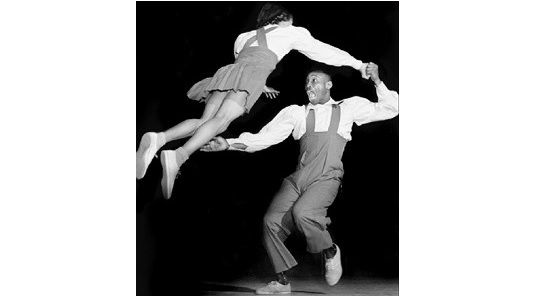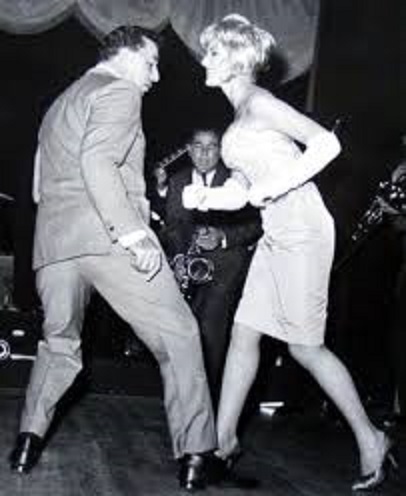Frankie Manning didn’t invent the “Lindy Hop”, but he was instrumental in making it popular. The Lindy Hop was a “street dance”, i.e., something invented by the dancers themselves, rather than more elite dancing instructors. (In that respect it shares with the sophisticated Argentine Tango, which grew out from its origins in brothels.) It was being developed at the Savoy ballroom in Harlem (a black ghetto in New York City), and got named the Lindy Hop by one of the dancers there (Georges “Shorty” Snowden) when he was asked by a journalist what its name was, who groped for an answer and found it in the headlines about Charles Lindbergh’s flight across the Atlantic. Lindy went national and became higher class (and its name was changed to Jitterbug), particularly with Benny Goodman and big band swing starting in 1936. Frankie Manning wandered by the Savoy in 1929, and soon became a passionate Lindy dancer and the ambassador for it … to the extent that he was worshipped around the world for his artistry. Frankie’s favorite song was Count Basie’s “Shiny Stockings”, which seems slow to Wilddancer for Lindy Hop, but you can see hundreds of folks doing it in a tribute video made on his 88th birthday. We at Wilddancer had been dancing for 10+ years when we saw a swing dancer do a back flip onto his hands, and back onto his feet during a “For Dancers Only” program at Stanford University on April 14, 2000 by Wynton Marsalis and the Lincoln Center Jazz Orchestra. It must have been Frankie Manning, who would have been “only 86” at the time. And he was 89 when he astonished a crowd in Sweden.
Tag Archives: jitterbug
The Gresham’s Law of Social Couples Dancing Today
Gresham’s law is an economic principle that is commonly stated as: “Bad money drives out good”. But this principle has much broader applicability. For example, to social couples dancing.
Human beings have a long history of dancing in some form, be it as individuals, couples, or groups. The first couples dance Wilddancer recognizes that is still being taught and done today in most western countries is the Mazurka, which started in the 1500’s. The first Waltz (the Volta) dates back to 1556, with many variations since then. The Ländler arrived in the Austrian countryside about 1690, then moved to Vienna and a variation became the Viennese Waltz. After these came (in historical order) the couples dances Bolero, Paso Doble, Polka, Merengue, Habanara and Milonga (now Tango), Foxtrot, Rumba, Samba, Lindy Hop (later called Jitterbug), Cha Cha, Mambo, East Coast Swing, Jive, West Coast Swing, Texas Two-Step, Hustle, and Nightclub Two Step.
People who have danced for many years will tell you that the Twist killed touch dancing. If so, the “Freestyle” that people have done for the last few decades (essentially waving your butt while shifting your feet a bit) has danced on its grave. Its two main virtues are that it does not take any training and it doesn’t take much space on a dance floor (assuming that the dancers are not too drunk). But it really isn’t a guy-gal couples dance, as one sees a lot of gal-gal couples (either the guys are in short supply or have two left feet). But the net result is that the unskilled dancers are monopolizing the dance floor and displacing the skilled ones, ergo Gresham’s Law of Social Couples Dancing.
Even worse, according to an essay entitled Dancing Properly by noted British philosopher Roger Scruton, Freestyle removes the sociability of the physical contact, and perpetuates the bad manners so rampant in current times.


